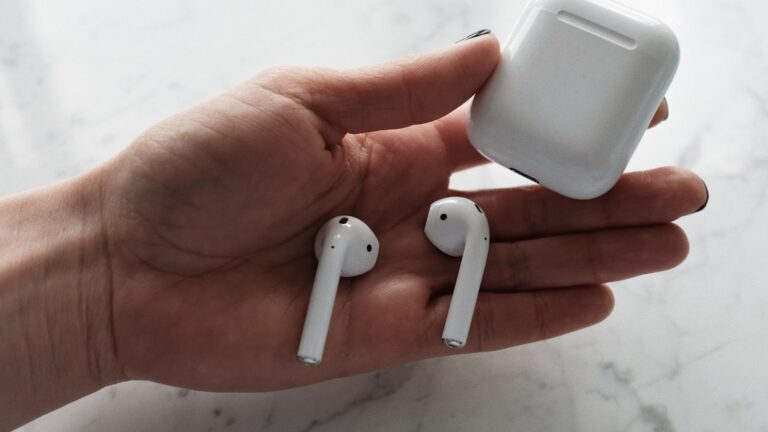Apple AirTags are a great way to stay organised and easily find lost items, whether your keys, wallet, or even your pet. Although AirTags are designed for Apple products, you can also use them with your Android phone.
In this article, we’ll provide a step-by-step guide on how to use AirTags with Android devices.
What are AirTags?
AirTags are small tracking devices from Apple, which are designed to help you keep track of your important items. AirTags utilise the Ultra Wideband (UWB) hardware inside iPhones, iPads, and Macs to locate and track AirTags. So not only can you use them to find items around your home, but they can also alert you when an item you’ve attached to an AirTag has been moved to a different place.
AirTags work with other Apple devices like the iPhone and iPad and Macs. Unfortunately, Android users don’t have the same level of integration with AirTags; they won’t be able to view the location of their tags in real-time or get notifications when a tag moves out of range.
However, Android devices can still connect wirelessly to any nearby AirTag using Bluetooth Low Energy (BLE). This will allow users to see if an item is nearby or has moved out of range. It also works even if the device has no cellular connection or data service. You can also mark important items that have been moved such as wallets and other small but valuable belongings for you to not forget where exactly you have put them in case they were taken out of range without your knowledge.
How to Use Apple AirTags on Android
AirTags are small wireless tracking devices that help to locate lost items using Apple’s Find My app. Although AirTags are optimised for use with Apple products, they can also be used on Android based devices after a few additional steps have been completed. Utilizing AirTags on an Android device provides numerous advantages and benefits.
One of the biggest advantages of using AirTags on Android is that users can utilize various finding options to locate their lost items. For example, using the Find My app, users can accurately map the location of their item and even view nearby locations where it was previously located. In addition, users can also receive notifications when their item is located in a previously visited area or moved outside of the designated search area.
Other benefits of using AirTags include:
- Enhanced privacy and security
- Customised alerts and sound effects
- Easy setup via Bluetooth connection
- Travel compatibility
- Detailed locating assistance
With AirTags enabled on an Android device, users can access multiple customizable features such as alerts for moving out of range and notifications for finding their item within the search radius. Moreover, Bluetooth connectivity features allow for quick and easy pairing with your device without any complicated set up process. Furthermore, AirTag technology offers travel-friendly components that prioritise geographic locations when searching for lost items so users do not have to worry about international roaming boundaries as they travel abroad with their device. Lastly, AirTag technology offers detailed locating assistance by providing step-by-step directions from your current location to quickly pinpoint your misplaced item whenever possible.
In conclusion, utilising Apple’s AirTag technology on an Android device presents a multitude of advantageous benefits including enhanced privacy and security measures; customizable alerts; easy setup; convenient travel compatibility; and detailed locating assistance offered by map integration through Find My apps location services feature – all designed to help ease the frustrations related to misplacing personal belongings anywhere within your vicinity or beyond!
Setting Up AirTags
The Apple AirTags are an amazing device that makes it easier to track all the items you own. The AirTags can be used on any device, whether it be Android or iOS, to easily locate items.

This section will discuss how to set up AirTags on an Android device. We will analyze the steps involved and any potential issues you may encounter during the setup process.
Download the Apple Find My app
Once you have your AirTag, the first step in setting it up for use with your Android device is to download the Apple Find My app from the Google Play Store. The Find My app is free to download and allows you to locate, connect, and manage AirTags across iOS and Android devices.
Before using your AirTag, it must be initialised and set up in the Apple Find My app. This includes adding your AirTag to an iCloud account so that its location can be tracked. To begin setting up an AirTag on an Android device, open the Apple Find My app on your phone and follow these steps:
- Tap the “+” at the top right of the screen
- Tap “Set Up New Device”
- Tap “AirTag”
- Follow the detailed instructions provided for setting up your AirTag
- Enter a name for your AirTag and confirm location services are turned on for accurate tracking
- Select whether or not you have an iCloud account; if not, create one before continuing
- Put a battery in your AirTag if applicable
- Scan the setup code found on bottom of of tag or tap NFC if available
- Finally, tap “Done” when prompted to complete setup process
Your newly added AirTags will now appear in a list under Devices Available which can be viewed by tapping “My Devices” at bottom of screen any time within this menu of settings within app itself found under “Account” button located top left corner of main menu screen home page first visited upon entering application opened find me AppStore GooglePlay from launching application open start-up launch icon logo image icon file photo album tutorial play store android Setup setup guide instructions command help manuel Tutorials.
Create an Apple ID
To use AirTags, you will need to have an Apple ID. You can create a split Apple ID for your Android device if you don’t already have one. To create an Apple ID on your Android device, follow the steps below:
- Launch the App Store on your Android device and open Settings.
- Select “Create New Apple ID” from the menu options.
- Fill out the information requested and tap Next when you are done.
- Accept the Terms and Conditions of Service and tap Agree to complete the process.
- Verify your account by entering a valid email address or phone number associated with that account into the provided field before tapping Verify Address or Phone Number, respectively.
- Once verified, select Sign In with Your Apple ID to sign in using your just created credentials and assign a passcode of 6 digits once prompted by the system to increase security of your digital credentials.
Set up your AirTag
Setting up your AirTag is straightforward. All you need to complete the setup process is a supported Android device with Bluetooth and NFC capabilities, accessed via a Google Account.
First, make sure that the device you’re using meets all the requirements— check your device’s requirements using our compatibility checker. Once you’ve verified this, you can begin the setup process.

To start, open the ‘Find My’ app on your Android phone or tablet and tap ‘Get Started’. You will then be asked to sign in with a Google account if you haven’t already done so. Once logged in, tap ‘Continue’ at the bottom of the screen to start finding your AirTag.
On the next page, tap on ‘Set Up an AirTag’. You will be prompted to hold your AirTag close to your Android device until it vibrates and emits a sound. This is when it officially pairs with your phone or tablet and can now be customised with an opening message and profile picture.
After setting up your profile information, you can customise how long notifications take when an AirTag moves out of range (up to three days). You may also choose whether or not notifications should appear on other Apple devices associated with your Apple ID (if applicable). Finally, analyze all the settings to ensure everything is accurate before tapping ‘Done’ — this completes setup for both devices!
Using AirTags on Android
Apple AirTags are a great way to keep track of your belongings and ensure they never go missing. But if you’re an Android user, you might wonder how to use AirTags on your device. Fortunately, you can take some simple steps to integrate AirTags into your Android device.
In this article, we’ll cover the basics of using AirTags on Android devices:
Download the Android Find My app
To use all the features of AirTags on an Android device, you need to download the Android Find My app from the Google Play store. The app lets you track lost items, view past locations and even trigger a sound or notification to help find it. It also allows you to keep an eye on AirTags that have been shared with you.
Before using the Find My app, make sure that Location is enabled on your device. You’ll also need a Google account and Bluetooth or NFC turned on to use all Find My features.
Once the Find My app is installed, open it then follow the instructions to create your AirTag(s). It will ask permission to access Bluetooth and GPS to scan for available networks and establish a connection with AirTag(s). Once connected, it will provide directions for setting up alerts for when an item is moved or left behind. You’ll also be able to get notifications if your item is located at an unfamiliar place.
The Find My app will notify if someone else’s AirTag enters its range. This helps alert other users that there could be another person tracking them without their knowledge – giving them a chance to take steps against unwanted surveillance.
Connect your AirTag to Android
Using AirTags on Android phones is easier than ever. Connecting your AirTag to a compatible Android device requires the installation of the Find My app, available from the Google Play Store. This process is straightforward and quick – once installed, you can use it to locate your items.
After launching the app, you’ll be prompted to create an Apple ID if you don’t already have one. From there, you can use the instructions in-app for pairing your AirTag with an Android device – it’s as simple as pointing your phone at the item containing your AirTag and following a few steps in the app. You only need to address a few prompts from within Find My including entering information such as where you lost something or want notifications sent to when a tag is moved beyond a certain distance from its place of origin.

Once registered, you’ll be able to view location-based notifications on your device and more detailed location data in Apples Find My website or app. Eventually, Apple will sync all this information across devices so users don’t have to switch between apps or websites depending on what phone they have; until then, this process will serve as a reliable alternative.
Set up notifications and alerts
Setting up notifications and alerts allows you to get an alert when a person holding an AirTag approaches you, if AirTags are found nearby that shouldn’t be there, or other situations related to the safety of your devices. Android users can set up these notifications through the Find My app.
Download and install the Find My app from Google Play Store to get started. After opening the app, sign in with your Google account to give it access to your device’s location information. This is important for notifications to work correctly. Once you’re signed in, tap “Manage AirTags” from the Settings tab on the left side of the screen. Here you’ll find various options for managing your AirTags like adding new ones or editing existing ones.
Make sure that Existing and Nearby AirTag notifications are turned on by tapping “Enable Notifications” at the top of this screen. This will prompt you to choose some preferences including whether or not you want to be alerted if someone else is using an AirTag near you, and how frequently this notification should appear on your device (every 7 minutes or every 17 minutes). You can also customise additional settings like what sound should play when a notification is received or if Find My should use Bluetooth Low Energy (BLE) beacon technology to detect nearby AirTags.
Once all these settings are configured according to your preference, press “Apply” at the bottom right corner of the screen to save all changes made to your notifications and alerts preferences related using AirTags on Android devices.
Troubleshooting
Apple AirTags are an incredibly useful way to track and locate items. However, if you’re an Android user, you may have trouble using AirTags. Luckily, there are a few steps you can take to try and make it work with your Android device.
In this section, we’ll discuss troubleshooting and how to use Apple AirTags on Android:
Check your Bluetooth connection
Using AirTags on Android requires the phone to have a stable Bluetooth connection. So before using AirTags, check that your Bluetooth connection is active and working properly. This can often be done by opening the Quick Settings menu on your device and enabling the toggle for Bluetooth.
If you’re experiencing difficulty viewing and finding your AirTag, it could also be an issue related to the visibility of your AirTag. To maximise its visibility, it’s recommended to pair and connect your Android phone with the AirTag via an upgraded version of the Find My app. Once paired, you’ll need to adjust settings on both devices (the Android phone and the AirTag) to ensure maximum potential for connectivity.
After initial set-up, users should make it a routine practice to check their Bluetooth connection at least once or twice a week or regularly if they’re using their AirTags more frequently. Maintaining a strong Bluetooth connection is key for ensuring optimal use when troubleshooting other issues that may arise down the road.
Check the battery level of your AirTag
When troubleshooting an AirTag, one of the first things to do is to check the battery level. The battery indicator in your AirTag can be viewed by placing the AirTag near your iPhone or other Apple device and holding it close. A green dot indicates that your AirTag has a full charge, while a red dot indicates that your battery is low and needs to be recharged.
If your AirTag does not have a green dot indicating a full charge, you will need to recharge it. Recharging an AirTag requires an Apple MagSafe Charger or another compatible wireless charger with induction charging capabilities. Ensure that device and charger are compatible with the corresponding standards required for magnetic induction charging before recharging your AirTag. Once connected, it should only take around 30 minutes for a dead battery to become fully charged again.
Once recharged, connect the AirTag again via Nearby to begin Troubleshooting issues related to its connection, accuracy or usage issues.
Reset your AirTag
In some cases, resetting your AirTag can help with any issues you are experiencing when using the device on an Android device. It’s relatively simple to reset your AirTag:
- Place the AirTag near your iOS device, and open the Find My app again.
- Tap Actions in the bottom right-hand corner of the screen and select “Play Sound.”
- Press and hold both buttons on your AirTag for 5 seconds or until you hear 3 beeps and a chime (this will put it into Lost Mode).
- Select Remove from Account on the top when the Lost Mode alert appears.
- Now, complete a ‘soft reset’ by pressing and holding both buttons for another 10 seconds until you hear 3 beeps in succession; this will set it back to its factory settings so you can start again with setup or pairing it with an Android device.
tags = apple find my network, bluetooth LE pings that other apple devices, bluetooth signal identifiers transmitted by airtags, apple android airtags airtagssherrcnet, apple android airtags find mysherrcnet, tracker airtags find mysherrcnet, apple tracker airtags find mysherrcnet, apple airtags find mysherrcnet, apple android airtags mysherrcnet, feature ensures you are able to get the precise location of the tracker




